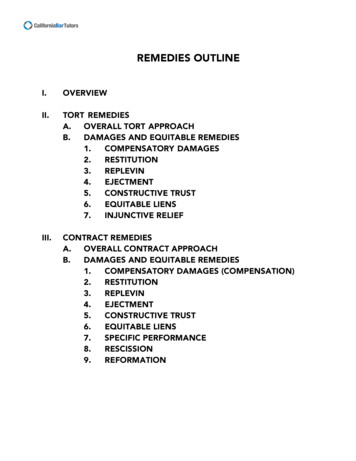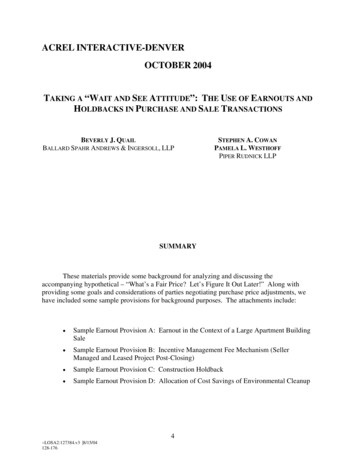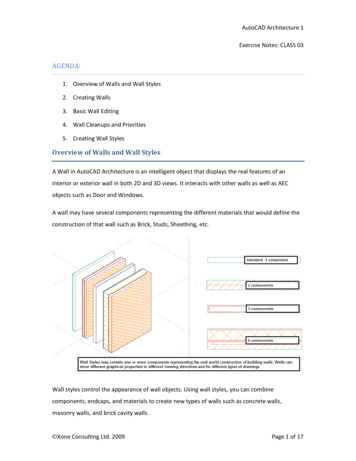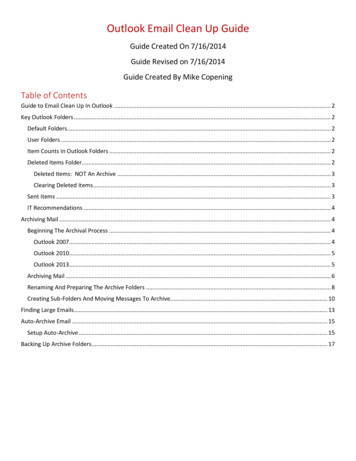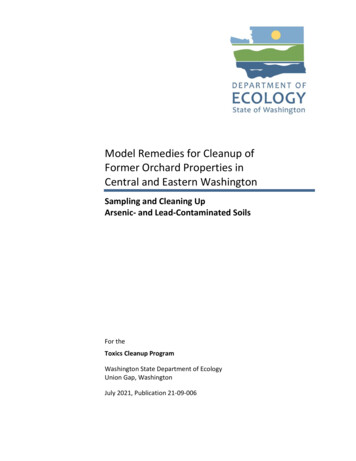
Transcription
Model Remedies for Cleanup ofFormer Orchard Properties inCentral and Eastern WashingtonSampling and Cleaning UpArsenic- and Lead-Contaminated SoilsFor theToxics Cleanup ProgramWashington State Department of EcologyUnion Gap, WashingtonJuly 2021, Publication 21-09-006
.Publication InformationThis document is available on the Department of Ecology’s website yPages/2109006.htmlRelated InformationFormer Orchard Property Soil Arsenic and Lead Levels. Ecology requires soil sampling forproperties in areas that were occupied by orchards prior to 1950 and are being converted toanother use.For an interactive map, visit: Dirt Alert Map 1Contact InformationToxics Cleanup ProgramCentral Regional Office1250 W. Alder StreetUnion Gap, WA 98903-0009Phone: (509) 454-7838Website 2: Washington State Department of EcologyADA AccessibilityThe Department of Ecology is committed to providing people with disabilities access toinformation and services by meeting or exceeding the requirements of the Americans withDisabilities Act (ADA), Section 504 and 508 of the Rehabilitation Act, and Washington StatePolicy #188.To request an ADA accommodation, contact Ecology by phone at 360-407-6341 or email atecyadacoordinator@ecy.wa.gov. For Washington Relay Service or TTY call 711 or 877-833-6341.Visit Ecology's website for more t/orchardwww.ecology.wa.gov/contact2
Department of Ecology’s Regional OfficesMap of Counties artersCounties servedClallam, Clark, Cowlitz, Grays Harbor,Jefferson, Mason, Lewis, Pacific, Pierce,Skamania, Thurston, WahkiakumIsland, King, Kitsap, San Juan, Skagit,Snohomish, WhatcomBenton, Chelan, Douglas, Kittitas,Klickitat, Okanogan, YakimaAdams, Asotin, Columbia, Ferry,Franklin, Garfield, Grant, Lincoln, PendOreille, Spokane, Stevens, Walla Walla,WhitmanAcross WashingtonMailing AddressPhonePO Box 47775Olympia, WA 98504360-407-6300PO Box 330316Shoreline, WA 98133206-594-00001250 W Alder StUnion Gap, WA 98903509-575-24904601 N MonroeSpokane, WA 99205509-329-3400PO Box 46700Olympia, WA 98504360-407-6000
Model Remedies for Cleanup ofFormer Orchard Properties inCentral and Eastern WashingtonSampling and Cleaning Up Arsenic- and Lead-Contaminated SoilsToxics Cleanup ProgramWashington State Department of EcologyCentral Regional OfficeUnion Gap, WAJuly 2021 Publication 21-09-006
Table of ContentsList of Figures and Tables . 9Figures.9Tables .9Acronyms & Abbreviations . 10Executive Summary . 11I need a No Further Action determination from Ecology .11Introduction. 12Health effects of arsenic and lead .12Model remedies .14Chapter 1: Soil Sampling . 16Purpose .16Initial Determination Sampling .17Site Characterization Sampling .17Decision units .18Sampling for a capping remedy .18Sampling for a mixing or excavation remedy.19Additional factors.20Soil: Where to sample .20Areas with fill, topsoil, or sod .21Collecting samples for laboratory analysis .21Sample collection steps .21Lab analysis .23Sampling by X-ray fluorescence detector .23Soil: Understanding your characterization results .23What to do next .24Chapter 2: Planning for Cleanup . 25Cleanup options .25Remedy Selection .25Additional options.26Additional sampling requirements .26Follow other government requirements for your project .27Reporting to Ecology .29Publication 21-09-006Page 5Model Remedies for Former Orchard PropertiesJuly 2021
Option to Pursue a No Further Action (NFA) determination .30Chapter 3: Model Remedy 1 – Excavation and Removal . 31Purpose .31Things to consider .31Excavation and disposal process .31Chapter 4: Model Remedy 2 – Mixing . 34Purpose .34Things to consider .35Characterization sampling helps to plan for mixing .35Mixing process .35Chapter 5: Model Remedy 3 – Capping in Place . 38Purpose .38Things to consider .38Soft caps .38Hard caps .39Capping process .39Chapter 6: Model Remedy 4 – Consolidation and Capping . 41Purpose .41Things to consider .41Process for consolidation and capping .41Chapter 7: Performance Compliance Sampling . 43Purpose .43When to do compliance sampling .43Sampling area .43When to sample .44Number of samples and sampling grid .44Sample depth .45Sampling by X-ray fluorescence detector .45Sampling process .45Understanding compliance results .45When am I done? .46Next steps .46Chapter 8: Stockpile Sampling . 47Publication 21-09-006Page 6Model Remedies for Former Orchard PropertiesJuly 2021
Purpose .47When to do stockpile sampling.47Planning for sampling .47Number of samples .47Sampling process .48Understanding your results .49Disposal .50Reusing soils on site as “clean” soils .50Chapter 9: Imported Soils Sampling . 51Purpose .51When to do imported soils sampling .51What contaminants to test for in imported soils.51Number of composite samples .52Sampling process .53Understanding your results .53Chapter 10: Environmental Covenants and Institutional Controls. 54Purpose .54Types of institutional controls .54What to include in your institutional controls .55How to prepare an environmental covenant .55Options for restricting access to capped areas .55Help Desk. 56Selecting an analytical lab .56Hiring and working with a consultant .56Special situations: Rights of way, utility trenches, swales, small construction.57Literature Cited. 59Appendix A: Model Remedies . 61Development of a model remedy .61Purpose of a model remedy.61Eligibility criteria for this model remedy.62How model remedies meet MTCA remedy selection and compliance monitoring requirements .63Appendix B: Forms. 68Form 1: Characterization Sampling .69Publication 21-09-006Page 7Model Remedies for Former Orchard PropertiesJuly 2021
Form 2: Characterization Sampling Results .72Form 3: Excavation and Removal .74Form 4: Mixing .75Form 5: Capping in place .76Form 6: Consolidation and capping .77Form 7: Compliance sampling.78Form 8: Stockpile sampling .81Form 9: Imported soils sampling .83Sampling and Cleanup Checklist .84Appendix C: Worksheets . 85Worksheet 1: Planning for excavation and removal .86Worksheet 2: Planning for mixing.88Worksheet 3: Planning for capping in place .90Worksheet 4: Planning for consolidation and capping .91Publication 21-09-006Page 8Model Remedies for Former Orchard PropertiesJuly 2021
List of Figures and TablesFiguresFigure 1: How to collect a soil sample. . 22Figure 2. Illustration of soil cover. . 38Figure 3: Illustration of landscaping materials. . 39Figure 4: Illustration of marker material. 39Figure 5: Illustration of hard cap material. . 39Figure 6: Combining decision units for compliance sampling. . 43Figure 7: Stockpile sampling process. . 48Figure 8: Imported soil sampling process (similar to stockpile sampling). 52TablesTable 1: State cleanup levels for arsenic and lead. 13Table 2: Model remedy options. 15Table 3: Minimum number of soil sample locations per decision unit for a capping remedy. . 19Table 4: Minimum number of soil sample locations per decision unit for mixing or excavation. 20Table 5: Pros and cons of excavating and removing contamination. . 31Table 6: Pros and cons of mixing contamination in with the soil. . 35Table 7: Example of soil profile before and after 24-inch mixing. 37Table 8: Pros and cons of capping contamination in place. . 38Table 9: Pros and cons of consolidating and capping contamination. . 41Table 10: Minimum number of compliance sample locations per decision unit. . 44Table 11: Number of composite samples per stockpile. . 48Publication 21-09-006Page 9Model Remedies for Former Orchard PropertiesJuly 2021
Acronyms & AbbreviationsAcronym or DefinitionAbbreviation , , , PbPLPppmRCWSEPATCLPTCPVCPWACWISHAXRFLess than, greater than, equal to, less than or equal toAmerican Disabilities ActArsenicChapterConstruction stormwater general permitDichlorodiphenyltrichloroethaneDecision unitWashington State Department of EcologyEnvironmental Protection AgencyfeetGeographic positioning systemHigh-efficiency particulate airInchesWashington State Department of Labor and IndustriesModel Toxics Control ActNo further actionLeadPotentially liable personParts per millionRevised Code of WashingtonState Environmental Policy ActToxicity characteristic leaching procedureToxics Cleanup ProgramVoluntary Cleanup ProgramWashington Administrative CodeWashington Industrial Safety and Health ActX-ray fluorescencePublication 21-09-006Page 10Model Remedies for Former Orchard PropertiesJuly 2021
Executive SummaryYou may use this document if: You have knowledge that your property was occupied by an orchard prior to 1950; or Your property is within the footprint of historical orchards found on the WashingtonState Department of Ecology’s Dirt Alert Map 3; or Untested fill was imported onto your property; and Lead and arsenic are the only suspected soil contaminants on your property.Additionally, if a site is managed to address lead and arsenic, Ecology believes that theseactivities will address exposure to other residual organic pesticides such as DDT. Furthermore,Ecology expects that organic pesticide residues will degrade below regulatory cleanup levelsover time, unlike lead and arsenic.If the criteria listed above apply, AND your property is no longer used solely for agriculturalpurposes, you can use this manual for sampling and cleaning up contamination from formerorchard use. You can meet state cleanup requirements without doing your own feasibility studyby carefully following the steps in this model remedy.I need a No Further Action determination from EcologyYou may not need a formal evaluation from Ecology if your cleanup is being conducted incooperation with a local government; however, if a local government permit office or lenderrequires Ecology’s formal written concurrence of your cleanup, you may enter the VoluntaryCleanup Program (VCP) to receive a No Further Action determination. Also, a future buyermight want to see Ecology’s written concurrence of your cleanup, so a formal NFA opinionthrough VCP may be valuable to you. The VCP provides non-binding, informal advice andtechnical assistance in the form of a written opinion. Additionally, if your cleanup is completedwithin 210 days from the initial sampling that confirms contamination, Ecology may formallyapprove your cleanup without having to enter the VCP. Additional information is in Chapter 2:Planning for Cleanup – Pursue a No Further Action (NFA) Determination.More information is available on Ecology’s VCP web pages 4.Or you may call 509-454-7842 or email at Jeff.Newschwander@ecy.wa.gov to speak withEcology’s Area Wide Contamination Project chardhttps://ecology.wa.gov/VCPPublication 21-09-006Page 11Model Remedies for Former Orchard PropertiesJuly 2021
IntroductionFormer orchard practices caused widespread soil contamination in agricultural areasthroughout Washington. This guidance addresses properties that were impacted by the use oflead arsenate, a pesticide used from the late 1800s until approximately 1950. Though theresulting lead and arsenic contamination is similar to what is found within the smelter plumesof western and northeast Washington, this document is specifically for the arid, irrigatedconditions in central and eastern Washington. Please contact your regional Washington StateDepartment of Ecology (Ecology) office if you are unsure whether this guidance applies to yourproperty.Goals of this guidance: To provide simple sampling and cleanup guidance for any former orchard property; To encourage independent cleanup during property development; To provide consistency and clarity for developers and home builders; and To encourage independent cleanup during smaller projects involving soil movement,such as landscaping, building a deck, or putting in a swimming pool.Health effects of arsenic and leadArsenic and lead are toxic metals. Exposure can increase the risk of certain health problems.Although these metals are not easily absorbed through the skin, living in close proximity to soilscontaminated with lead and arsenic will likely result in ingestion of soil and inhalation of dust.Ecology is concerned about small children and people that are regularly exposed to soil, such asconstruction workers, landscapers, and gardeners.Scientists have linked long-term exposure to arsenic to a variety of health problems, includingheart disease; diabetes; and cancer of the bladder, lung, skin, kidney, liver, and prostate. Leadcan cause behavioral problems, permanent learning difficulties, and reduced physical growth.Ecology’s soil cleanup level for lead is based on preventing unacceptable levels in blood.Whether someone is impacted depends on the amount of arsenic or lead taken into their bodyover time (EPA 2021). People exposed to contaminated soil on a regular basis may be affected.Children and workers are at highest riskYoung children are of the greatest concern because lead can have a significant impact on thedeveloping brain (EPA 2021). Children are also more likely to be exposed. They play on theground and put their hands in their mouths. The small amount of arsenic or lead that they mayswallow is more harmful because they are still growing. Children can be exposed to arsenic orlead while playing outside and inside. Soil and dust can easily be tracked into homes fromoutside.Publication 21-09-006Page 12Model Remedies for Former Orchard PropertiesJuly 2021
Construction workers, gardeners, and landscapers can also be exposed to contaminated soil ata work site by accidentally ingesting soil or inhaling dust. Employers are responsible for meetinghealth and safety requirements at work sites to limit worker exposure. Employers shouldcontact Washington Department of Labor and Industries (L&I) 5 for more information.Why sample?Ecology requires initial determination sampling when a property is within the footprint ofhistorical orchards found on the Washington State Department of Ecology’s Dirt Alert Map 6,and when that property is proposing a change in land use. The historical presence of an orchardon a property can be determined by looking up the address on Ecology’s Dirt Alert website.More specifically, sampling is required when these properties transition from vacant oragricultural use to a use that may increase human exposure to these contaminants. Undercertain circumstances, Ecology may be
Model Remedies for Cleanup of Former Orchard Properties in Central and Eastern Washington Sampling and Cleaning Up Arsenic- and Lead-Contaminated Soils
